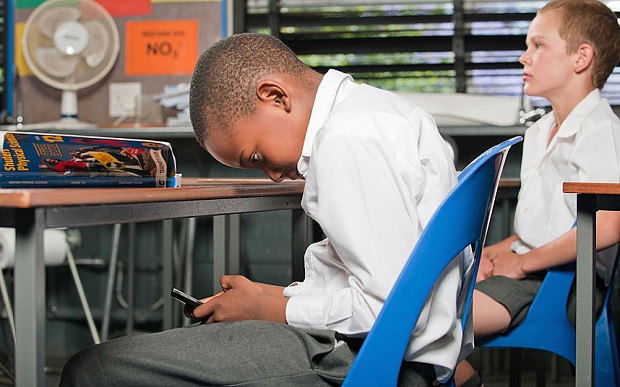Children ‘becoming hunchbacks’ due to addiction to smart phones

Children as young as seven are developing hunchbacks and curved spines because of the hours spent bending over smart phones and tablets, a chiropractor has claimed.
Dr James Carter warned that he had seen an “alarming increase” in the condition, which he called “text neck”.

He said patients often came in complaining of a headache but that a simple heel-to-toe test revealed that they had developed a backwards curve in the neck having spent hours hunched over electronic devices.
“I have started seeing lots of cases over the past two years, especially in young schoolchildren and teenagers,” Dr Carter told Daily Mail Australia.
“The condition is called ‘text neck’ because it is often caused when people sit with their heads dropped forward looking at their devices for several hours at a time.
“Instead of a normal forward curve, patients can be seen to have a backwards curve. It can be degenerative, often causing head, neck, shoulder and back pain.
“Many patients come in complaining they have a headache, but we actually find text neck is the cause of it. They often fail a simple heel-to-toe test and tend to fall over.”
Sammy Margo, from the UK’s Chartered Society of Physiotherapy, agreed that “text neck” was on the rise.
She said: “When you drop your chin on to your chest for a long period you are stretching the whole structure.
“Eventually, in conjunction with a sedentary lifestyle, it could lead to serious consequences.”
Dr Carter, from Niagara Park on Australia’s New South Wales Central Coast, warned that the condition could lead to anxiety and depression as well as spinal damage.
And he said 50 per cent of the patients he diagnosed were school-aged children and teenagers.
A recent survey by the consultancy ComRes for Channel 4 News found just over half of parents worried their kids were exposed to sexual content on their electronic devices, while 52 per cent said they were worried about them meeting strangers online.
It also found that children spend an average of nearly three hours a day in front of their screens – whether playing games, watching videos on YouTube or using social media.
Dr Carter advised avoiding using laptops or phones while sitting or lying in bed and raising monitors or devices to eye level.
Dr Chris McCarthy, a consultant spinal physiotherapist at Imperial College Healthcare NHS Trust in London, cautioned against the use of X-rays to diagnose such a condition.
He expressed concern that patients suspecting they had the condition would go to their GP and expect to have an X-ray, which he said were not recommended in the treatment of neck pain and would expose them to unnecessary radiation.
Whilst he said he had heard of “text neck”, he suggested that the broader problem was more likely to stem from a sedentary lifestyle and a general lack of exercise.
“Non-specific neck pain can be related to sedentary postures,” he said.
“As physios, we would support a notion that if a child does not do any exercise and stays in a static position playing computer games and on Facebook there is more chance they will get spinal pain, including in the neck.”












